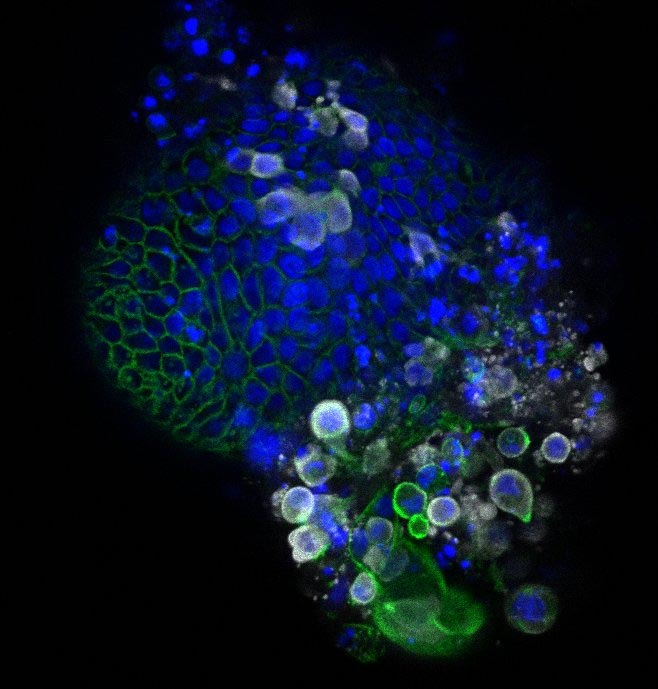- Scientists have looked at how the novel coronavirus behaves inside an artificial small intestine organoid made from stem cells.
- The new study reveals that the virus can infect some gastrointestinal cells in the same way it infects lung cells.
- These findings could explain the diarrhea and nausea that some COVID-19 patients experience, and the research could be used to determine whether fecal-oral transmission is a cause of concern.
- Visit BGR’s homepage for more stories.
One of the qualities of the novel coronavirus that makes it so dangerous is that it doesn’t have many specific symptoms that are telltale signs of an infection. Instead, the most common symptoms include signs that present with other viral infections, including the flu. Fever, cough, and shortness of breath might make you think you’ve been infected, but it can be something else entirely. The sudden loss of taste or smell is the closest thing we have to a telltale COVID-19 symptom, but it doesn’t present itself in all those infected.
Other symptoms that can appear in COVID-19 cases can include sore throat, headache, muscle pain, and chills, but these can also develop in other conditions. Then there are gastrointestinal symptoms, including diarrhea and vomiting. The CDC doesn’t include them in the list of COVID-19 symptoms but does mention that children might experience them. These gastrointestinal symptoms are unusual for respiratory diseases, but researchers have finally explained why it happens.
Scientists from Hubrecht Institute in Utrecht, Erasmus MC University Medical Center Rotterdam, and Maastricht University in the Netherlands have been able to grow an artificial gut (an organoid) from adult stem cells. they then tried to infect it with the SARS-CoV-2 virus that causes the COVID-19 disease. The researchers discovered that the virus can bind to epithelial cells of the intestine by hooking up to the same ACE2 receptor that lets them enter the lungs. They published their findings in Science Magazine.
Once these cells are invaded, the virus can continue to replicate and increase in number just like it does in the lungs. Moreover, the whole thing starts generating an immune response when the body detects the pathogen. “These organoids contain the cells of the human intestinal lining, making them a compelling model to investigate infection by SARS-CoV-2,” Hubrecht Institute’s Hans Clevers told SciTech Daily.
Gastrointestinal symptoms can appear in up to one-third of COVID-19 patients, the report notes. There are worries that the virus can spread via “fecal-oral transmission.” Also, other studies theorized that fecal aerosols in bathrooms could infect other people.

Using electron microscopy, the scientists were able to determine the presence of the virus on gastrointestinal cells and found them replicating over time. The white regions in the image above indicate the presence of the coronavirus inside the cells of the organoid, which is colored in blue and green.
The researchers discovered that the virus can enter cells regardless of the level of ACE2 receptors. Even cells with low levels of ACE2 may become the host of replication for the virus. The researchers also looked at the response of the intestinal cells with RNA sequencing. They found that interferon-stimulated genes are activated after an infection, or genes that are known to fight a viral infection.
“The observations made in this study provide definite proof that SARS-CoV-2 can multiply in cells of the gastrointestinal tract,” Erasmus MC’s Bart Haagmans told the blog. “However, we don’t yet know whether SARS-CoV-2, present in the intestines of COVID-19 patients, plays a significant role in transmission. Our findings indicate that we should look into this possibility more closely.”
While the new study is definitely interesting, it’s unclear what sort of viral concentration in food is required to lead to diarrhea and nausea. Also, it’s unclear how infectious patients showing such symptoms are for other people. Not to mention that the research can’t explain how fast the immune system would clear the gut. But the study proves yet again that good hygiene is of utmost importance whether there’s an epidemic around or not.
On a related note, we’ve discussed before that ordering food from restaurants is safe even if said food is covered with the novel coronavirus. That’s because COVID-19 is a viral disease, and serious complications can arise only after the lungs are infected. Moreover, the actual cooking of food will also destroy all traces of the virus, which is why you should reheat your food at home if you want to be extra safe.








